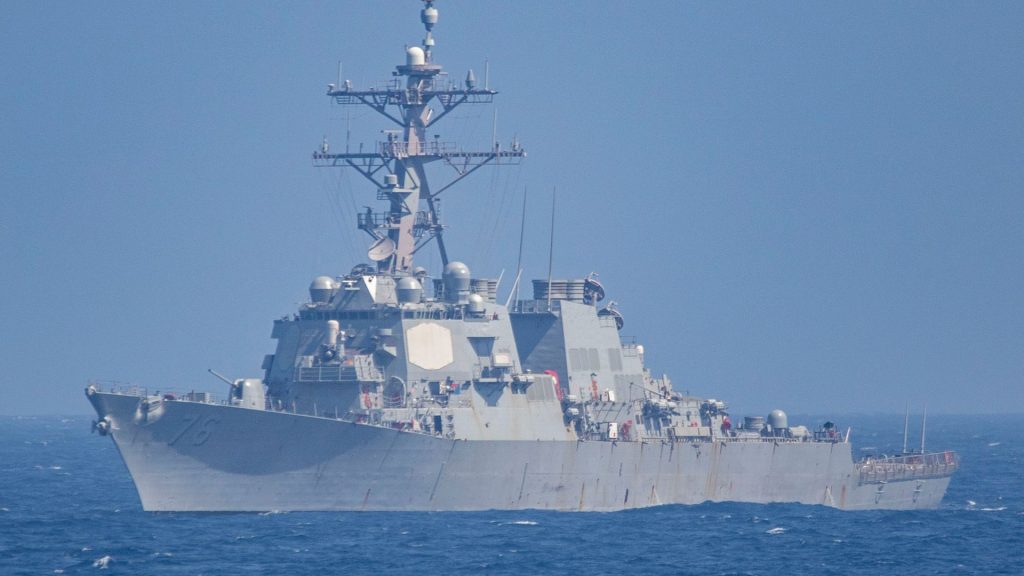Reloading at sea: US Navy’s answer to China’s missile advantage

U.S. naval destroyers are among the most powerful surface combatants in the world, but they face a logistical challenge: once they fire their missiles, they typically need to head to port to reload. That’s a vulnerability in any sustained fight, and one the Navy is urgently working to solve.
In late July, the crew of the USS Higgins became the latest group of sailors to practice what the Navy calls ‘enhanced expeditionary logistics capabilities‘ by simulating the reload of a Standard Missile-2 (SM-2) while anchored off the coast of Townsville, Australia.
The event marked another step in developing the ability to conduct expeditionary vertical launch system (VLS) reloads — a capability Navy leaders say will be vital in any future high-end conflict.
Practicing the process
The July exercise was a simulation only — no missile or training round was actually loaded. Even so, leaders hailed the training as an important milestone.
“This gives our warfighters a tremendous amount of agility to strike from sea, move, reload, reposition, and strike again,” Rear Adm. Eric Anduze, commander of Task Force 70, said. “It represents a lethal tactical advantage that helps us protect the safety and prosperity of the region.”
Chief Warrant Officer 3 Kevin Kodrin, ordnance officer for Task Force 73, emphasized the teamwork required, calling the exercise “the result of exceptional collaboration between the ship’s crew, shore support teams, and technical experts.”
Reloading at sea: not easy
Reloading a VLS cell was traditionally done only in controlled port environments, often with cranes and calm waters. The complexity of the operation historically prevented navies from attempting the task at sea.
But in recent years, the U.S. Navy started experimenting with new methods, including the Transferrable Reload At-sea Method (TRAM). TRAM was first demonstrated aboard the USS Chosin in October 2024, when sailors successfully transferred and lowered a missile canister into the ship’s VLS cells while underway.
Then, Secretary of the Navy Carlos Del Toro called TRAM “game-changing,” adding it would allow warships to stay near the fight and maintain pressure on adversaries instead of sailing long distances to rearm.
Lessons learned
The Navy’s push to master at-sea reloads is informed by recent operational experiences. In the Red Sea, U.S. destroyers expended hundreds of missiles defending commercial shipping from Houthi-launched drones and rockets. Those operations often forced warships to leave the area to reload, creating gaps in coverage.
Analysts warn that a potential fight with China would be far more demanding. The People’s Liberation Army Rocket Force maintains a vast arsenal of ballistic and cruise missiles. Sustaining defenses against a Chinese missile barrage could exhaust U.S. magazines quickly, making the ability to reload at sea a critical factor in survival.
It’s simple math. If the adversary has a lot to shoot, it takes a lot of missiles to defend. Leaving station to reload creates vulnerabilities the U.S can’t afford in a high-end fight.
Building regional readiness
The USS Higgins’ July drill follows other expeditionary reloads in the Indo-Pacific. In 2023, USS Rafael Peralta rearmed in Eden, Australia, after participating in exercise Talisman Sabre. A year later, USS Dewey conducted a similar reload in Darwin after exercise Kakadu.
The Navy says it is now focused on training destroyer crews throughout the region in expeditionary reload techniques. These efforts are part of a larger push to strengthen distributed logistics and sustain combat operations far from U.S. shores.
As Anduze put it, “strengthening these logistics capabilities ensures our ships remain combat-ready whenever and wherever needed.”





